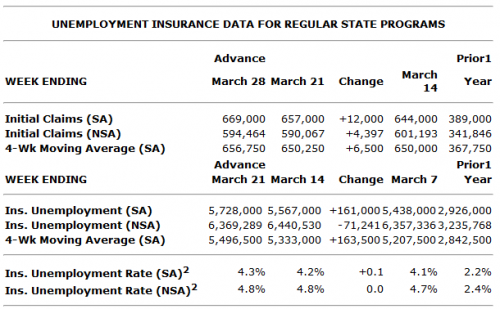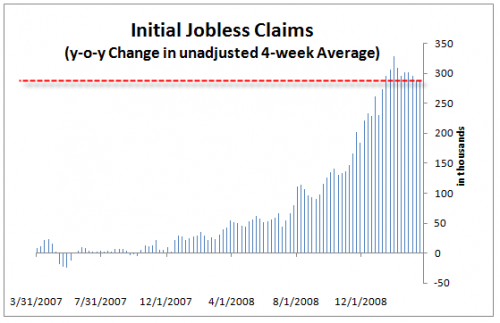Are jobless claims peaking?
Tomorrow, we all await the unemployment number with anticipation. In all likelihood, it is going to be a nasty number edging us ever closer to the 9.0% I once saw as a sort of upper range number for 2009.
Meanwhile, jobless claims for the week ended March 28 are out. The reported numbers of 669,000 initial jobless claims and 5.7 million continuing claims are both seasonally adjusted (SA) and they are both high than the previous week. 4-week SA averages are also higher.
On digging deeper, here is my analysis:
Looking at the non-seasonally adjusted (NSA) numbers, things actually look a bit better. Initial claims rose from 590,000 to 594,000 claims while continuing claims fell by 70,000 to 6.37 million. (Click here to see why I do not use the reported SA numbers.)
But, I actually like to look at trends, so I am taking the 4-week NSA number and comparing it to last year. Below is the chart.
As you can see, the graph clearly indicates that the change in initial jobless claims has peaked (temporarily?). These peaks are not lagging indicators, they are usually coincident or leading indicators. Here are the dates and numbers for peaks in changes in initial claims going back to 1967 when the data began:
- 5 December 1970 at 120,000 (the recession ended in November 1970)
- 1 Feb 1975 at 361,000 (the recession ended in March 1975. Note: Apr-Jun 1974 showed positive GDP growth)
- 7 Jun 1980 at 238,000 (the recession ended in July 1980. Note: this was the first in a double dip recession)
- 30 Jan 1982 at 202,000 (the recession ended in November 1982. Note: Apr-Jun 1982 showed positive GDP growth)
- 23 Mar 1991 at 154,000 (the recession ended in March 1991)
- 20 Oct 2001 at 165,000 (the recession ended in November 2001)
I hope this makes it pretty clear that the last few recessions show changes in initial jobless claims as a coincident or leading indicator. Moreover, the peak in this cycle right now stands at 327,000 on 31 Jan 2009, which was 2 months ago. Today, we are at 275,000, quite a bit lower. Now, unless the SA weekly initial jobless clams start hitting 700,000 – 800,000 this spring and summer, we have already seen the peak here.
I should also point out that changes in the unemployment rate and initial jobless claims are also not the lagging indicators that the unemployment rate itself should be considered.
So, is this a pause in the data? It is hard to say, honestly. But, my sense from previous cycls is that we have seen the peak here. But, this is a completely different economic cycle, the likes of which we have not seen in quite a while. So, the data comparisons back to 1967 could be misleading. And maybe layoffs at a bankrupt Chrysler or GM will make things much, much worse – something that the Obama team should remember when those deadlines come due.
I point all of this out because the punderati in the econblogger space is very negative these days, but the data are not all pointing in that direction.
Source
Unemployment Insurance Weekly Claims Report – U.S. Department of Labor


Very nice analysis correlating recession stop date with peaking claims in UI.
Me, I think the fundamental driver for consumption (and, ultimately, initial claims for UI) is household debt-to-GDP (or DPI). Until we see household deleverage, consumption will continue its downward movement (it peaked in Nov. ’07) and initial claims for UI will continue their upward movement.
Interesting Edward – question, what probability do you assign on a 1. peak in change 2. another Q308 type effect ? Any idea if this is the same type of correlation in other countries ?
I intend to write more on this later but I am seeing evidence that we are getting a massive inventory correction here. I had mentioned in an earlier post that inventory builds meant that Q1 GDP was going to be ugly. But it looks like businesses are going to town on this meaning that we could really see some favourable numbers by Q4.
So, combine this with the potential peak in employment, tax cuts, fiscal stimulus, quantitative easing, yada yada.. and you have the makings of a recovery. How possible is this recovery? I’d give it a healthy 25-30% probability by Q4.
Also, I see the M2M rule change as negative long-term but bullish short-term because it eliminates some of the writedowns I saw being necessary. This could mean lending will increase if the Geithner plan purges some assets from balance sheets.
Mind you, all of this is cyclical and I don’t like the optics or transfer of burden from banks to taxpayers. But, it is coming together nicely and I think that is one reason stocks are rallying.
As for the Q308 type effect, what was that exactly? And also, the correlation, I didn’t get that one either.
looking to your graph above, we can see a small decrease in Q308
right. if you go back to my posts: look at the ones tagged jobless claims:
https://pro.creditwritedowns.com/tag/jobless-claims
I’m sure you’ll see me hemming and hawing about where the data is headed. To my mind it was clear that we were in recession by that time, but how severe it would become was not readily apparent.
Just looking at an Aug 28th post, I said:
And remember, many people were still denying that we were even in recession! Lehman put an end to that notion.
There is only one problem in the YOY analysis. Last year the YOY claims was already rising – that is 2008 was showing greater losses as compared to 2007. So what you need to do is look at 2009 compared to 2007 – i.e. year over 2 years. I keep track of this data. There is too much statistical noise in week to week data – but if you use a 4 week average of the 2 year change, you’ll see that the rate of increased losses has plateaued for 2 and a half months at around 320,000 per week. There has been no drop off.
The drop off you are seeing is the rise in losses in 2008…
Thanks for the message, fyego. What I generally have looked for is a substantial enough rise in unemployment statistics to warrant a pull-back in consumer spending or to presage a fall-off in production. I don’t use the two-year period that you look at because it is too much of lag to measure that change I am looking for.
So I look at 1-year or 6-month comparisons. I have started to use only 1-year -week average NSA data because it is not distorted by seasonality. Yes, these 2nd derivative comparisons capture both the rise/fall today as well as the rise/fall of the comparison data — but that is what I am looking for: an appreciable change in a short enough period of time that would indicate a large swing in economic activity.
So, even if we saw a rise in 2008 from 2007, a further rise in 2009 must still be sizeable enough to demonstrate a large swing in economic activity from 2008 to 2009.